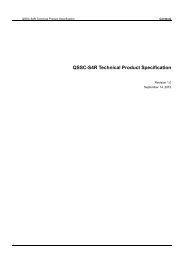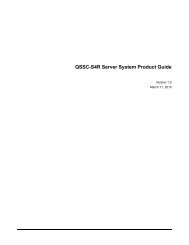Intel® Server System Server System "Emerald Ridge ... - CTL
Intel® Server System Server System "Emerald Ridge ... - CTL
Intel® Server System Server System "Emerald Ridge ... - CTL
You also want an ePaper? Increase the reach of your titles
YUMPU automatically turns print PDFs into web optimized ePapers that Google loves.
錯 誤 ! 尚 未 定 義 樣 式 。 EPSFunctional SpecificationCodeReason for Beep1-5-4-2 Power fault: DC power unexpectedly lost(power good dropout).1-5-4-4 Power control fault (power good assertiontimeout).Associated SensorsPower unit – power unit failureoffset.Power unit – soft power controlfailure offset.SupportedYesYes3.12.1 Signal GenerationThe BMC generates an NMI pulse under certain conditions. The BMC-generated NMI pulseduration is at least 30 ms. once an NMI has been generated by the BMC, the BMC does notgenerate another until the system has been reset or powered down.The following actions will cause the BMC to generate an NMI pulse:Receiving a Chassis Control command to pulse the diagnostic interrupt. This commanddoes not cause an event to be logged in the SEL.Detecting that the front panel diagnostic interrupt button has been pressed. See Section3.5.5.4.Watchdog timer pre-timeout expiration with NMI / diagnostic interrupt pre-timeout actionenabled.The following table shows behavior regarding NMI signal generation and event logging by theBMC.Causal EventChassis Control command (pulse diagnosticinterrupt)Table 9. NMI Signal Generation and Event LoggingNMI (IA-32 Only)Signal GenerationFront Panel Diag Interrupt Sensor Event LoggingSupportX –Front panel diagnostic interrupt button pressed X XWatchdog Timer pre-timeout expiration with NMI/ diagnostic interrupt actionX –3.13 Sensor Rearm Behavior3.13.1.1 Manual vs. Rearm SensorsSensors can be either manual or automatic re-arm. An automatic re-arm sensor will "re-arm"(clear) the assertion event state for a threshold or offset if that threshold or offset is deassertedafter having been asserted. This allows a subsequent assertion of the threshold or offset togenerate a new event and associated side-effect. An example side-effect would be boostingfans due to an upper critical threshold crossing of a temperature sensor. The event state andthe input state (value) of the sensor track each other. Most sensors are auto-rearm.A manual re-arm sensor does not clear the assertion state even when the threshold or offsetbecomes deasserted. In this case, the event state and the input state (value) of the sensor donot track each other. The event assertion state is "sticky".The following methods can be used to re-arm a sensor: Automatic re-arm – Only applies to sensors that are designated as “auto-rearm”.Revision 1.1Intel ® Confidential 23









